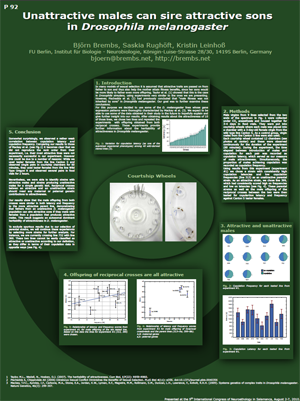
The next triennial
International Congress of Neuroethology is coming up next week in Salamanca, Spain. We will have two posters this time and the first (number P92 in the
abstracts book) is our undergraduate project on fruit fly mating behavior. This is a project where a lot of pilot experiments had been carried out without any clear result. Now, finally, I think we have the right experimental design that's doable by undergraduates and yields unambiguous data. We picked 10 highly inbred, isogenic wild type lines from
Drosophila melanogaster (out of a total of 40 lines described in
this article). We picked the top and bottom five lines on a scale of copulation latency (i.e., the time it took for males to copulate with a female of a neutral tester strain). One could say we picked the lines with the most attractive and the most unattractive males, respectively. One of the lines went extinct repeatedly, so we dropped that one and tested the remaining 9 lines. We tested both copulation latency and copulation frequency (i.e., how many of the tested pairs actually copulated. From these experiments, we picked two lines which were consistently successful and unsuccessful, respectively. We then set up reciprocal crosses between the two strains and found that the sons of both crosses were highly attractive, even if their fathers were very unattractive.
Could this be a case of
hybrid vigor? We are currently testing this hypothesis with several more crosses.
Posted on Thursday 29 July 2010 - 19:19:48
comment: 0{TAGS}






